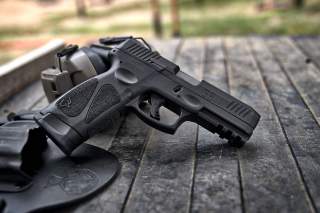Brazil's Answer to the Glock 19 Gun: Meet the Taurus G3
An expert tells us what he thinks--and if it can take out the legendary Glock 19.
Key Point: At the end of the day, the G3 is just cheaper.
High capacity nine millimeter pistols were first introduced to the public as service pistols. Built for military and police without regard for size, service pistols were full-sized handguns that prioritized recoil reduction and magazine capacity over concealability. Over the years a compromise has evolved, resulting in a pistol mixing all three features. The Glock 19 is cited as the ideal compromise, and Taurus’ G3 pistol very much runs in that vein--but at a substantially lower cost.
The Glock 17 handgun was originally designed for the Austrian armed forces and then exported to civilian markets worldwide. The Glock 17 is a reliable handgun that, while lightweight, still has enough heft to absorb the modest recoil of the nine millimeter round. This makes it an excellent gun for conscript armies, where soldiers may not have a background in firearms. It also features a large, seventeen round magazine allowing soldiers to carry more rounds on their person.
The Glock 17 did well in the American commercial market but many buyers clamored for a handgun with a shorter barrel and slightly shorter magazine, resulting in the Glock 19. This defined the “sweet spot” for many compact nine millimeter handguns, and Brazil’s Taurus steps into that spot with the G3 pistol.
Forjas Taurus, or Taurus, was established in Brazil in 1939 as a tool and die manufacturing company. The company produced its first pistol, the 38101SO, in 1941, and began exporting pistols to the United States in 1968. Briefly controlled by Smith & Wesson, the Brazilian company broke with its American parent in 1977--but not before absorbing many handgun technologies. The company became adept at producing clones of Smith & Wesson style .38 caliber revolvers, and by the 1980s was copying firearms such as the Beretta 92.
Now, in the late 2010s, Taurus is producing the G3 as a compact, high capacity handgun and a Glock 19 competitor. While the two handguns are very similar, there’s no denying that Glock has a historical edge in reliability. Perhaps balancing that for some users is the significantly lower cost of the G3, which takes advantage of lower labor costs in South America to present a pistol typically found in the $250 range--about half that of the Glock.
Like the Glock 19, the G3 is a striker-fired, polymer frame handgun with a steel slide and barrel. Also like the Glock, the G3 can carry up to fifteen rounds of nine millimeter Luger ammunition in a double stack magazine. At 7.28 inches long and at 5.2 inches tall it’s virtually identical dimensionally to the Glock. It’s even the width, 1.25 inches, although one reviewer notes that the G3 would be narrower but for the manual safety mechanism. The G3 weighs 25 ounces unloaded, making it four ounces heavier than a Glock 19.
The G3 has all of the latest safety features in modern pistols, starting with a manual safety. This allows a user to carry the pistol loaded, safety on, ready to fire at the flick of a lever. The pistol has not one but two safety mechanisms designed to ensure a finger is on the trigger when the weapon fires: a blade safety on the trigger itself and a striker block mechanism. Both prevent the handgun from discharging due to an accidental fall or jolt. Finally, a loaded chamber indicator pops up on the frame when the pistol is loaded, showing at a glance that the pistol is live and ready to fire. Although a safety feature the loaded chamber indicator is also useful in shooting situations, making actions like press checks unnecessary.
The G3 is does lack features found in more expensive handguns. The Brazilian pistol includes factory stippling on the frame, as well as finger shelves for resting fingers when not aiming the pistol while preparing to fire. The pistol lacks features such as grip modules, interchangeable palm swells, and fully ambidextrous controls. The manual safety and magazine release are both positioned for right-handed shooters.
The G3’s sights are best described as inexpensive and consist of a single white dot post at the front of the slide and two dots on a Novak-style rear post. The sights are adjustable for windage. In addition the Brazilian gun has a Picatinny rail that runs under the barrel, allowing the user to add weapon lights, lasers, or other devices. The slide lacks a cutout for installing a red dot or reflex sight.
The G3 is a little longer, a little taller, a little heavier, and a little wider than its competitors. The G3 is designed to take on the Glock 19, but its main advantage is in pricing. The G3 costs less than half the price of the Austrian pistol, and if history is any guide is likely less reliable. That having been said, with a street price of $250 it’s an option for those looking for a handgun and on a budget.

